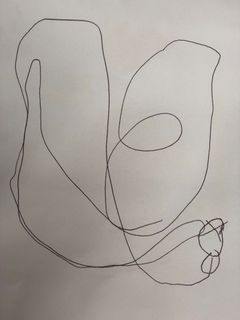Developing writing in the Early Years
In Kinder tuminana this week, I have been reminded of the wonderful process by which emergent writers become more adept at transferring their thoughts to paper.
The realization that what they are putting on paper conveys meaning to someone else is a powerful moment to be a part of.
I have a Dad in Kinder tuminana who has wallpapered his shed, pictured below right, with his daughter’s paintings as they tell the story of her first weeks in Kindergarten doing her favourite thing - painting. The fact her paintings are displayed shows the importance of them to her family and her learning and she has an important message to convey.
I have long been an advocate of drawing as a first step in the writing process. Every child can draw every day using a variety of materials.... the important step is what we do with it once they have completed it.
As the example of this father shows, displaying and discussing our children’s attempts at drawing, mark making (or early approximations of letters) and writing ensures they begin to see the importance of the activity.
Writing is a complex interaction of cognitive and physical factors involving the hand, eye, and both sides of the brain therefore learning to write cannot be separated into just one lesson. It is the culmination of many factors in early childhood and while children’s experiences with print prior to school will be varied, most children come to school with the ability to talk, play, tell stories and draw.
This is the starting point for writing development in the Early Years classrooms. Modelled and shared writing experiences are prominent in each classroom and lead our children into the writing process with scaffolded support and structure.
There are links between reading, writing and spelling that are not always explicit. Making these obvious to our students helps capitalize on their development prior to attending school. Associate Professor Noella Mackenzie from Curtin University, recently conducted a study whereby she asked teachers to change their writing program to focus on drawing for the first part of the year for the students first full year at school.
Her findings overwhelmingly supported the use of drawing and mark making as an introduction to helping young students develop confidence in becoming writers during their first years at school.
She also identified the importance of the teachers role in supporting students to explore, experiment and document their days through drawing and exploratory writing such as marks, random letters, initial sounds and invented spelling.
Classroom programs varied with the one common element being the emphasis on drawing as part of the writing program. However, the findings confirm that drawing is an important personal means of expression which ‘when used with confidence, ease and enjoyment, allows for a confident and prolific flow of ideas’ and that what the teacher prioritises does make a difference to student learning opportunities.
In the Early Years we encourage and value drawing, to can build a bridge between children’s prior-to-school experiences, a current system of meaning making and the new system of writing. In this way writing links with drawing as a parallel means of meaning making rather than a replacement for the drawing and talking they already do so well when they arrive at school.
As can be seen from the above photos children develop at different times throughout the year in every class. The range of development in Kinder and Prep is immense and scaffolded to support every child in their endeavor to become independent writers.
Mrs Jane Doyle - Coordinator of Teaching & Learning K-2
 A Catholic School in the Salesian Tradition
A Catholic School in the Salesian Tradition



